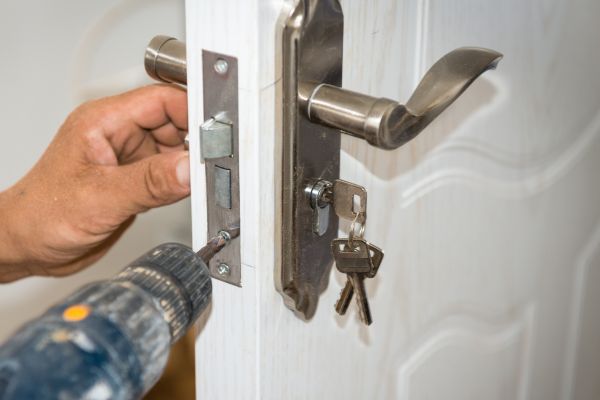New Home Safety Checklist

Congratulations on your new home! Use this checklist to inspect and set up safety functions right after moving in.
Secure Your Entry Points:
- Change the locks: This is the first and most crucial step for your peace of mind. Rekey or replace all locks on exterior doors, including the garage, shed, and any side or back entrances.
- Reinforce doors: Consider adding deadbolts or reinforcing strike plates for extra security.
- Check windows: Make sure all windows lock securely and have no damage. Check for cracks or gaps in window frames and seal them.
- Garage security: If you have a garage, check the door’s functionality and ensure it locks properly. Make sure the automatic opener has a rolling code feature to prevent hacking. Consider a smart garage door opener for remote monitoring and control.
Emergency Safety & Procedures:
- Test existing smoke and carbon monoxide detectors: Replace batteries if needed and make sure they’re in working order on every level of your home.
- Install smoke detectors in every bedroom, outside sleeping areas, and on every level of your home, including the basement. Install carbon monoxide detectors near sleeping areas and on each level. Test them monthly and replace batteries annually.
- Locate existing fire extinguishers: Place fire extinguishers in easily accessible locations, such as the kitchen, garage, and near fireplaces. Make sure everyone in the household knows how to use them.
- Plan escape routes: Create a fire escape plan with two exits from every room, and practice it with everyone in the household.
EMC Security monitors for fire and CO at no additional monthly cost!
Childproofing:
- Install window guards or window stops to prevent falls from elevated windows.
- Use cordless window coverings to eliminate hazards for young children.
- Secure heavy furniture to walls using anti-tip brackets or straps to prevent tipping accidents.
- Install cabinet door locks. Place all cleaners and hazardous materials high up.
- Install security gates in strategic places such as at the stairways.
Water Safety:
- Locate main water shut-off valve: Learn how to turn off the water supply in case of a leak.
- Inspect for leaks: Check under sinks, around toilets, and in basements for any signs of water damage or leaks.
- Water heater safety: If you have a gas water heater, have it inspected by a professional to ensure it’s operating safely.
- Consider a smart-water detection device: If water is detected, you will be notified and can take quick action.
Electrical Safety Check:
- Locate electrical panel: Find the main electrical panel and learn how to turn off the power in an emergency.
- Inspect outlets and switches: Look for any signs of damage or wear. If you find any, get them repaired promptly by a qualified electrician.
- Check GFCI outlets: Ground Fault Circuit Interrupter (GFCI) outlets are essential in bathrooms, kitchens, and outdoor areas. Test them to make sure they’re working correctly.
- Surge protection: Safeguard your electronics and appliances from damaging power surges, offering comprehensive protection from a central point.
Security System and Cameras
- Consider a free EMC Security professional consultation to assess your home’s specific needs and recommend the best security system for you.
- Activate/install alarm system: If your home has an existing alarm system, contact EMC Security to activate it. If not, consider installing a new EMC Security system for added protection.
- Test the alarm: Once the system is up and running, test it to make sure all sensors and alarms are working properly.
- Set up security cameras: Install cameras in strategic locations around your property. Review footage regularly to monitor for any suspicious activity. EMC Security can help you choose the right cameras for your needs.
- Smart locks: Replace traditional locks with smart locks that can be controlled remotely via your smartphone.
Smart Home Integration:
- Connect smart devices: If you have smart locks, thermostats, or other devices, connect them to your EMC Security alarm or smart home hub.
- Set up routines and automations: Create schedules or triggers to automate tasks like locking doors at night or adjusting the thermostat based on your preferences.
- Remote access: Download the apps for your smart devices to control them remotely and receive notifications.
Exterior Safety Assessment:
- Landscaping: Trim overgrown bushes or trees that could provide cover for intruders. Remove any loose rocks or objects that could be used to break windows.
- Lighting: Install motion-sensor lights around your property, especially near entry points, walkways, and dark corners.
- Sheds and garages: Secure these structures with sturdy locks. Consider adding EMC Security alarms or cameras for extra security.
- Pool area: If you have a pool, ensure it’s fenced off and has a self-closing, self-latching gate to prevent unauthorized access. This is also a good area for an alarm system device.
Additional Safety Tips:
- Create a home inventory: Take photos or videos of your belongings in case of theft or damage.
- Emergency kit: Prepare a kit with essential supplies like water, food, a first-aid kit, and flashlights.
- Get to know your neighbors: Building relationships with your neighbors can enhance your overall sense of security and community.
Home safety is an ongoing process. Regularly check your home’s safety features and make updates as needed. Enjoy your new home with peace of mind!
